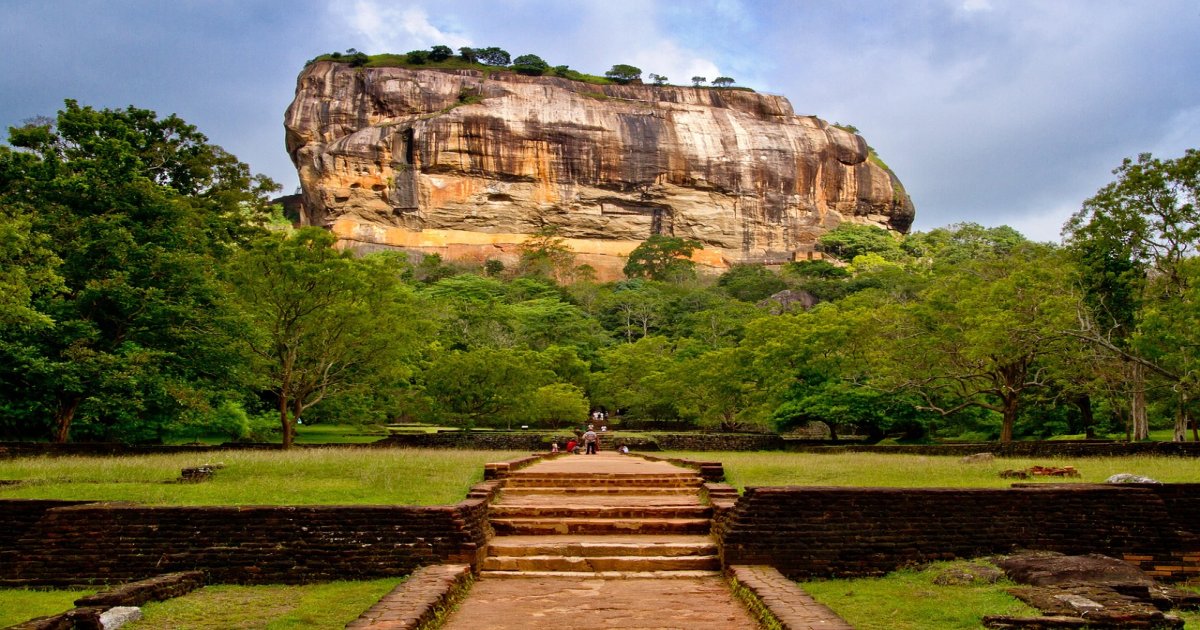One of Sri Lanka’s most amazing and intriguing tourist destinations is the Sigiriya Lion Rock. This location is a UNESCO World Heritage Site and is home to a massive, unique rock fortification that is unmatched anyplace else in the world.
This is one of Sri Lanka’s most fabled locations, and the castle has a long history. Throughout the years, it has served several purposes and satisfied many requirements for local monarchs, rulers, and religious authorities.
It is one of the top places to visit in Sri Lanka and a magnificent illustration of ancient architecture and human creativity.
Together with very well-preserved paintings and rock art, the area also has enormous gardens that have been manicured through time and surround the large rock itself. There are also ancient ruins that date back thousands of years.
This is a location that should not be missed, and in order to assist you in planning your journey, we have included a visitor’s guide to Sigiriya, Sri Lanka.
The Lion Rock of Sigiriya, Sri Lanka:
Where in Sri Lanka is Lion Rock?
In a historically significant area with several ancient sites, Sigiriya, Sri Lanka is situated in the country’s central province. The rock itself is rather remote, and Dambulla, the closest sizable town and transportation center, is about 20 miles distant.
Dambulla is the entrance of Sigiriya, and buses from all around the nation stop here.
It would take at least 4 hours to commute by public transportation from the capital to Colombo, which is around 120 miles distant. You may also go from well-known locations like Anuradhapura in the north or Kandy in the south.
You may either hire a native tuk-tuk driver or take a public bus from Dambulla to Sigiriya.
When is the best time to visit the Lion Rock of Sri Lanka?
As long as you don’t mind taking a chance on heavy downpours during the wettest times of the year, Sigiriya is accessible all year long. Outside of the region’s dry season, which lasts from April to September, monsoons often hit the area.
Traveling during the monsoon may be a chance to visit this amazing landmark with a few other people around, as long as you don’t mind getting a bit wet. Of course, the busiest season, when the lion rock can be entirely crowded, is the dry season.
While visiting Sigiriya, Sri Lanka, it is important to aim to get there as early as you can to escape the worst of the throng and the stifling heat.
It’s recommended to hike the steep series of stairs to the top of the rock early in the day to prevent becoming too hot under the intense Sri Lankan sun.
History of the Lion Rock, Sigiriya
One of the most amazing remains of a former Sri Lankan civilization is Sigiriya. Because of the big Lion’s Paw that was carved into the massive rock beside the entrance protecting the way in, the name of the enormous rock itself translates to English as the Lion’s Rock.
Geologically, the rock, which towers about 200 meters high, is a plug left behind from the ashes of a long-extinct volcano.
Even without taking into consideration the extensive history and amazing ruins that can be seen here, the enormous rock is stunning enough on its own.
Early Buddhist monks were among the first inhabitants to seek refuge in the vast caverns located in the rock, and it is believed that the region has been inhabited for thousands of years.
When King Kashyapa assumed control in 477 AD, he decided to relocate his capital to Sigiriya, Sri Lanka, and he started to transform this rock into not just his castle and fortress but also into a sizable planned city.
But, the king’s dominion was overthrown in 495 AD, and the Lion’s Rock started to deteriorate. The rock was given to Buddhist monks by the new king of these areas, and it remained a significant temple complex for many years until once again being abandoned and overtaken by nature.
It was “rediscovered” in 1831 by British troops in Sri Lanka, and ever since, it has drawn intense archaeological attention. More recently, it has grown to become one of the nation’s most popular tourist destinations.
Get into Lion Rock fortress in Sri Lanka
A series of steep stairs with approximately 1200 steps leads to the top of this spectacular rock.
To enjoy the wide vistas and the palace and castle remains that are waiting for you, it’s worth the hot and grueling climb to the summit.
But, you must first pass through the neighborhood museum at the main gate to this vast estate before starting the ascent.
This provides a thorough history of Sigiriya as well as the tales and myths associated with it. The rich history will help you understand the significance of the location for earlier civilizations, especially for the founding monarch who constructed his castle here more than 1500 years ago.
There is a museum!
The museum also gives special attention to the many excavations that have been conducted over the last century, starting with those conducted by the British in the 1890s, who only gradually came to understand the significance of their original rediscovery of it.
It won’t take you long to discover that this was more than simply a castle once you step foot within the grounds. The early architects who constructed Sigiriya planned and developed the whole city to the highest standards.
You will enter the spectacular grounds after you pass through the main gate. As Sigiriya was being planned, a massive water reservoir that could support thousands of people living in this royal capital was created.
The gardens, however, are much more stunning. You must traverse the stunning, green landscapes that have been here for generations in order to get to the rock.
The monarch gave the order to build them as a status symbol and for the enjoyment of the aristocracy and royalty. They are maintained lush and green by an army of employees toiling in the heat today. They are regarded to be one of the first instances of landscaping in the whole globe.
Climb up to Lion Rock’s peak
It’s time to climb the rock when you have finished admiring the plants. Bring lots of water, sunscreen, and a hat to protect yourself from the harsh sun. Since the rock is nearly perfectly vertical, over a thousand and two hundred stairs were physically cut into the slope so that people can climb to the summit.
Take it easy and enjoy the breathtaking vistas as you approach since the trail may be rather steep in some areas. You may take in the many cave paintings painted directly into the rock walls while strolling.
Another significant location is the Mirror Wall, which was first believed to have been used as a mirror by the monarch since it was so well polished.
Following an hour of ascent, you will reach the peak, where you may examine the palace’s remains in addition to being welcomed by sweeping views of the gardens below and the surrounding, lush woodlands.
You can still get a feel of the impressive architectural designs and intricate construction work that made it possible for this site to be erected atop the rock, even if there isn’t much remaining since the passage of time has caused most of the brickwork to collapse over the years.
Walking is the sole option for returning down the route, although it is considerably simpler to do so going downhill.
Visit the temple of Pidurangala
Only one mile separates Pidurangala Temple from Sigiriya. This temple is located at the foot of a cliff that is just as unique and impressive as Sigiriya, although it is far less popular with visitors and much less crowded.
This rock gives stunning views of the surroundings and, from its top, you can practically see Sigiriya in the distance, despite being less significant historically than its neighbor.
This makes it a great spot to gain an idea of the scope and breadth of this enormous, historic project. The trek is hot and taxing, so it’s best to use a tuk-tuk to get here.
Where to stay in Sigiriya?
Budget tourists are advised to remain in Dambulla and then go to the rock by tuk-tuk or public transportation. Nevertheless, if you want to splurge out a bit, you may stay closer and have the option to enter the rock even sooner than everyone else to avoid the crowds.
The Hotel Sigiriya, which is situated within the confines of the UNESCO World Heritage Site and provides the greatest accommodations and service in the region, is the most well-known and magnificent hotel choice near the rock.
We personally enjoyed our stay at the Cinnamon Habarana Lodge very much. They have a sizable, exclusive estate that is encircled by the outdoors. The service is excellent, and the rooms are enormous.
Depending on the time of year, they may also organize trips to Dambulla and Polonnaruwa, as well as safaris in the adjacent towns of Kaudulla or Minneyira.

